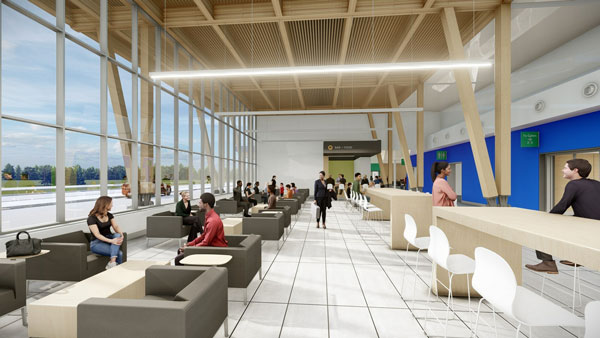After years of planning and preparation, a new Manitoba airport terminal at Thompson Regional Airport is finally becoming reality, with work progressing on the steel infrastructure of the building.
The redevelopment is part of a $135-million, large-scale venture that includes a new water treatment facility completed in 2020, as well as extension of sewer lines from the new terminal to an expanded lagoon, parking lots, lighting, service roads and airside-related infrastructure.
“Construction on the terminal started in May and the steel structure is flying up as we speak,” Curtis Ross, CEO and president of the Thompson Regional Airport Authority, said in an interview.
The decision to gear up for a new and larger 40,000-square-foot modern terminal was made in 2007 after an engineering report stated the structure had only a few years of life left because the permafrost was melting, causing the existing 14,000-square-foot building to sink.
Design of the structure, land clearing and other work took place between 2010 and 2017. On the airside, the runway was extended to 5,800 feet and new drainage and lighting systems were installed.
The new Manitoba airport terminal building is expected to be finished and commissioned by the spring of 2025.
‘It wasn’t just, let’s build and here we go tomorrow’
“It’s been a long time coming,” said Ross. “It’ taken us 10 years to get the site ready and do the geotechnical drilling to make sure we’re not drilling on permafrost and build a temporary road and get the approvals and the permits to clear some bush.
“It wasn’t just, ‘Let’s build and here we go tomorrow.’ It’s been a long-planned-out strategic goal of the airport.”
Ross said the existing terminal situation was untenable and the airport needed a building that was more resilient to climate change.

“The plan was always to replace the old terminal because half of it was sinking due to discontinuous permafrost,” he noted. “It was progressively getting worse.”
When the current airport was built in 1961 by the International Nickel Company to serve mining operations, it was only supposed to be temporary. The foundation of the terminal was laid on an ancient glacier riverbed which resulted in it sinking into the permafrost over the years.
Ross said structures can be built on discontinuous permafrost, but it’s how they’re built and what systems are used. To support the new terminal, steel piles are being driven into the ground to diffuse the weight.
“It’s almost like building on stilts, and then you backfill, and you put mitigation measures underneath and around the building,” said Ross.
The new terminal is being built near the end of the airport’s runway. By building a new terminal a distance from the present facility, and close to the highway system, operations are not disrupted.
“We’re going to be fully functional in our existing building until the day we flip the switch in the new one,” explained Ross. “The new one has brand new aprons, brand new taxiways, everything that will connect up to the existing runway and we just move from site A to site B.
“It’s a really nice way of doing it because we can just flip the switch. Once we’re comfortable that all systems are working, we just close the road to the old one and open the road to the new one.”
Airport a lifeline for Indigenous communities
A rendering of the new Manitoba airport terminal shows a sleek-looking, single-storey structure with separate arrival and departure entrances, flat rooftops on various sections, plenty of windows and external wood supports on a main area. Inside, the terminal is airy with exposed wooden support beams.
In addition to typical airport terminal public and support program areas, unique features of the structure include a First Nations elders lounge and facilities to accommodate Medevac operations.
The building will feature a mix of in-floor heating, and HVAC systems and hydronics for heating and cooling. The structure will feature sustainable elements and meet energy efficiency standards as electrical systems and windows have been designed to meet Manitoba Hydro requirements.
Energy-efficient materials like structurally insulated panels will be used for the walls to provide better insulation and mechanical systems will be put inside a “penthouse” on the roof so equipment and machinery are not exposed to the elements. Putting the systems indoors should lead to lower heating costs because equipment will not have to heat itself as well as the building.
The airport, which is six kilometres from the City of Thompson, is a vital lifeline for transportation of goods and services to 65,000 people in 37 remote and Indigenous communities in northern Manitoba and western Nunavut. Fifteen of those communities are only accessible by air and an ice road in winter.
The Canada Infrastructure Bank has provided a $52-million, long-term loan to help finance the redevelopment project through its Indigenous Community Infrastructure Initiative which aids projects that deliver a direct benefit to Indigenous communities.



Recent Comments